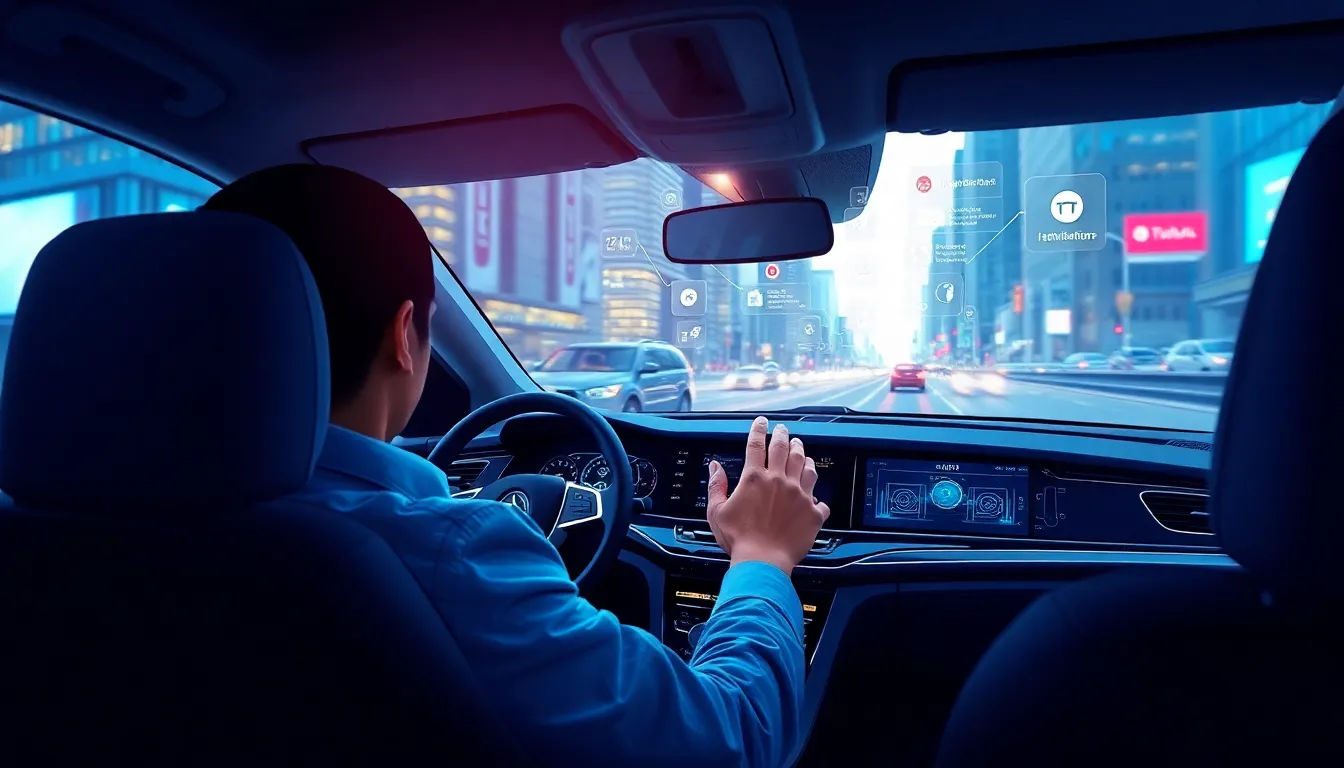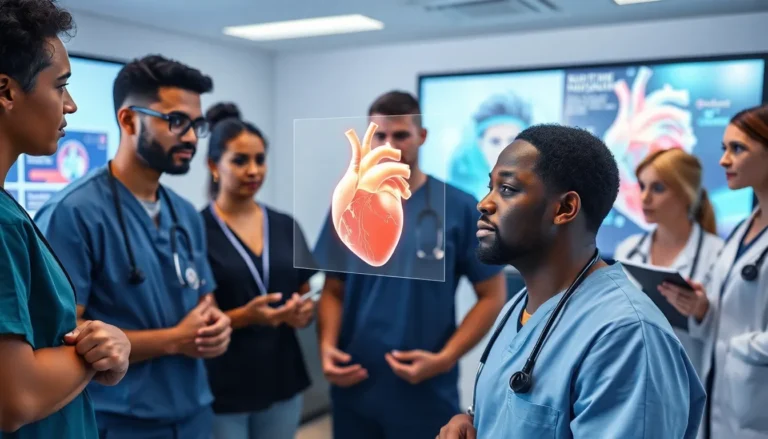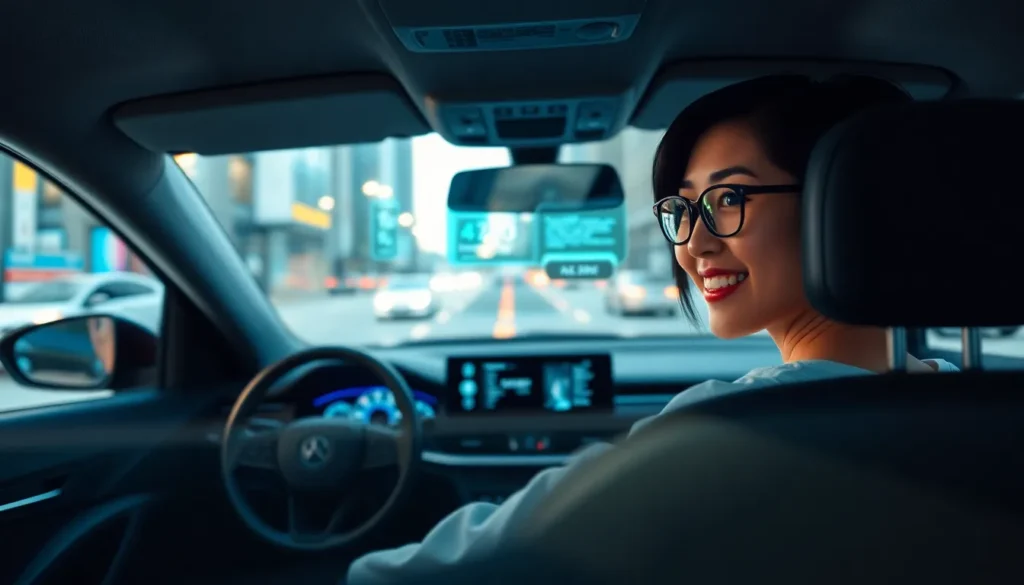Table of Contents
ToggleImagine cruising down the highway while your car’s dashboard transforms into a high-tech command center, guiding you with real-time data and holographic displays. Augmented reality is revving up the automotive industry, turning everyday driving into a futuristic experience. It’s not just about getting from point A to point B anymore; it’s about enjoying the ride with a side of innovation.
Overview of Augmented Reality for Automotive
Augmented reality (AR) significantly transforms the automotive industry by enhancing the driving experience. It integrates digital information with the real world, making dashboards more interactive and informative. These advanced displays show real-time navigation, vehicle data, and vital alerts directly on the windshield or dashboard. This development allows drivers to access crucial information without taking their eyes off the road.
Innovative applications of AR in automotive include heads-up displays that project navigation directions, speed limits, and hazard warnings. By eliminating the need for physical navigation devices, these systems reduce distractions. They allow drivers to stay focused on the road while receiving essential guidance.
Furthermore, AR contributes to safety by providing warnings about nearby obstacles and potential hazards. These systems use sensors and cameras to detect surroundings and offer timely alerts, enhancing situational awareness. As a result, AR not only improves driving comfort but also prioritizes safety.
Manufacturers are increasingly investing in AR technology to differentiate their vehicles in a competitive market. Some brands have integrated AR into their consumer interfaces, creating a high-tech environment for users. This advancement attracts tech-savvy customers who seek modern features in their vehicles.
Ultimately, augmented reality represents a significant evolution in automotive design and functionality. It moves beyond traditional displays to create an immersive and connectivity-oriented experience. By leveraging AR, the automotive industry aims to redefine the future of mobility and enhance overall user engagement.
Benefits of Augmented Reality in Automotive

Augmented reality revolutionizes the automotive experience by offering distinct advantages. Increased interactivity enhances user engagement, transforming mundane tasks into enjoyable activities.
Enhanced User Experience
Drivers gain access to real-time navigation data displayed through heads-up displays. Furthermore, augmented reality provides personalized interfaces that adapt to individual preferences. A touch of a button activates multimedia features, enriching the driving experience. Passengers also enjoy interactive entertainment options, making long journeys more enjoyable. By introducing a blend of virtual elements with actual surroundings, augmented reality makes vehicles feel more connected to users.
Improved Safety Features
Safety improves significantly with augmented reality applications. Enhanced warnings about nearby objects or conditions provide drivers with immediate alerts. Digital overlays display speed limits and road signs directly on the windshield, minimizing the need to glance down. Manufacturers implement features that project navigation prompts, reducing distractions. With AR technology, collision warnings become more intuitive and timely, promoting proactive driving. Overall, these enhancements create a safer driving environment, ensuring that attention remains focused on the road.
Applications of Augmented Reality in Automotive
Augmented reality (AR) presents various applications in the automotive sector, enhancing navigation and maintenance processes. These applications improve user experiences and engage drivers more effectively.
Navigation and Heads-Up Displays
Navigation has evolved dramatically with AR technology. Heads-up displays project essential information directly onto the windshield, allowing drivers to receive navigation directions while keeping their focus on the road. Such displays can show speed limits, estimated arrival times, and nearby points of interest. With real-time data integrated, drivers avoid distractions from traditional navigation systems. AR enhances situational awareness by highlighting potential hazards. Innovative features keep users informed about critical vehicle information, further streamlining the driving experience.
Maintenance and Repair Assistance
AR simplifies maintenance and repair tasks, providing significant assistance to both technicians and vehicle owners. Through AR applications, users can access visual overlays on vehicle components, guiding them during repair processes. These overlays often include step-by-step instructions, ensuring accuracy and efficiency. Technicians can diagnose issues using AR displays that illustrate system status and performance data. Vehicle owners benefit from easy visual guides that empower them to perform simple maintenance tasks confidently. Consequently, AR fosters a deeper understanding of vehicle upkeep, promoting effective and timely service.
Challenges and Limitations
Augmented reality in the automotive industry faces several challenges and limitations. One primary concern involves the high costs associated with developing and implementing AR technology. Automakers must invest significantly in hardware and software integration, which can strain budgets, especially for smaller companies.
Distraction also poses a threat. While AR aims to enhance user experience, overly complex displays might divert drivers’ attention from the road. Effective design balanced with simplicity proves crucial in preventing cognitive overload.
Another limitation lies in technological reliability. AR systems depend on accurate data collection, which can be hampered by environmental conditions such as poor weather or signal interference. Systems may fail to provide essential information under these circumstances, risking driver safety.
User acceptance presents an additional hurdle. Individuals may feel apprehensive about adopting new technologies within their vehicles, especially seniors or those less familiar with digital interfaces. Educating users on benefits ensures smoother transitions to AR-enhanced driving experiences.
Legal and regulatory obstacles remain relevant. The introduction of AR features necessitates compliance with various regulations focusing on vehicle safety and driver distraction. Navigating these legal landscapes complicates the rollout of new technologies.
Finally, data privacy concerns arise with AR applications. Collecting and processing sensitive user information raises questions about how that data is managed and protected. Addressing these concerns will be essential as manufacturers develop and deploy AR systems within their vehicles.
Future Trends in Augmented Reality for Automotive
Emerging trends in augmented reality (AR) are reshaping the automotive landscape. One significant trend involves the integration of AR with autonomous driving technologies. Vehicles equipped with AR display relevant data on the windshield, enhancing the overall autonomous experience. Real-time updates on surroundings promote situational awareness, leading to safer navigation in complex driving scenarios.
Innovative heads-up displays are gaining prominence. They project essential information such as speed limits, navigation aids, and hazard alerts directly in the driver’s line of sight. Increased personalization features allow drivers to customize their AR experiences, enhancing engagement through tailored information displays. Improved user interfaces promise increased accessibility to various functionalities, encouraging safer vehicle operation.
A shift towards collaborative features is evident as well. Vehicle-to-everything (V2X) communication capabilities integrate AR with surrounding infrastructures. This interconnectivity offers enhanced information about traffic patterns, weather conditions, and road hazards. Drivers benefit from comprehensive insights, allowing for more informed decisions.
Investment in AR technology continues to rise. Major automotive manufacturers are allocating resources to develop cutting-edge systems, striving to attract tech-savvy consumers. Emerging startups are also entering the market, pushing boundaries by creating unique AR applications tailored to specific automotive needs.
Challenges remain evident amid these advancements. Addressing high development costs continues to be crucial for maintaining competition in the industry. Simplifying user interfaces promotes ease of use, particularly for those unfamiliar with technology. Ensuring regulatory compliance and data privacy further remains essential as AR systems evolve. Prioritizing user education will help enhance acceptance among diverse customer demographics as AR technology in automotive progresses.
Augmented reality is poised to revolutionize the automotive industry by enhancing user engagement and safety. As manufacturers continue to invest in this technology, drivers and passengers alike will experience a new level of interaction and convenience. The integration of real-time data into vehicles not only simplifies navigation and maintenance but also transforms the driving experience into something more enjoyable and efficient.
While challenges like development costs and user acceptance persist, the potential of AR to redefine mobility is undeniable. As the industry evolves, the focus on user education and streamlined interfaces will be crucial in ensuring that this innovative technology is accessible to all. The future of automotive AR looks bright, promising a safer and more connected driving experience.







